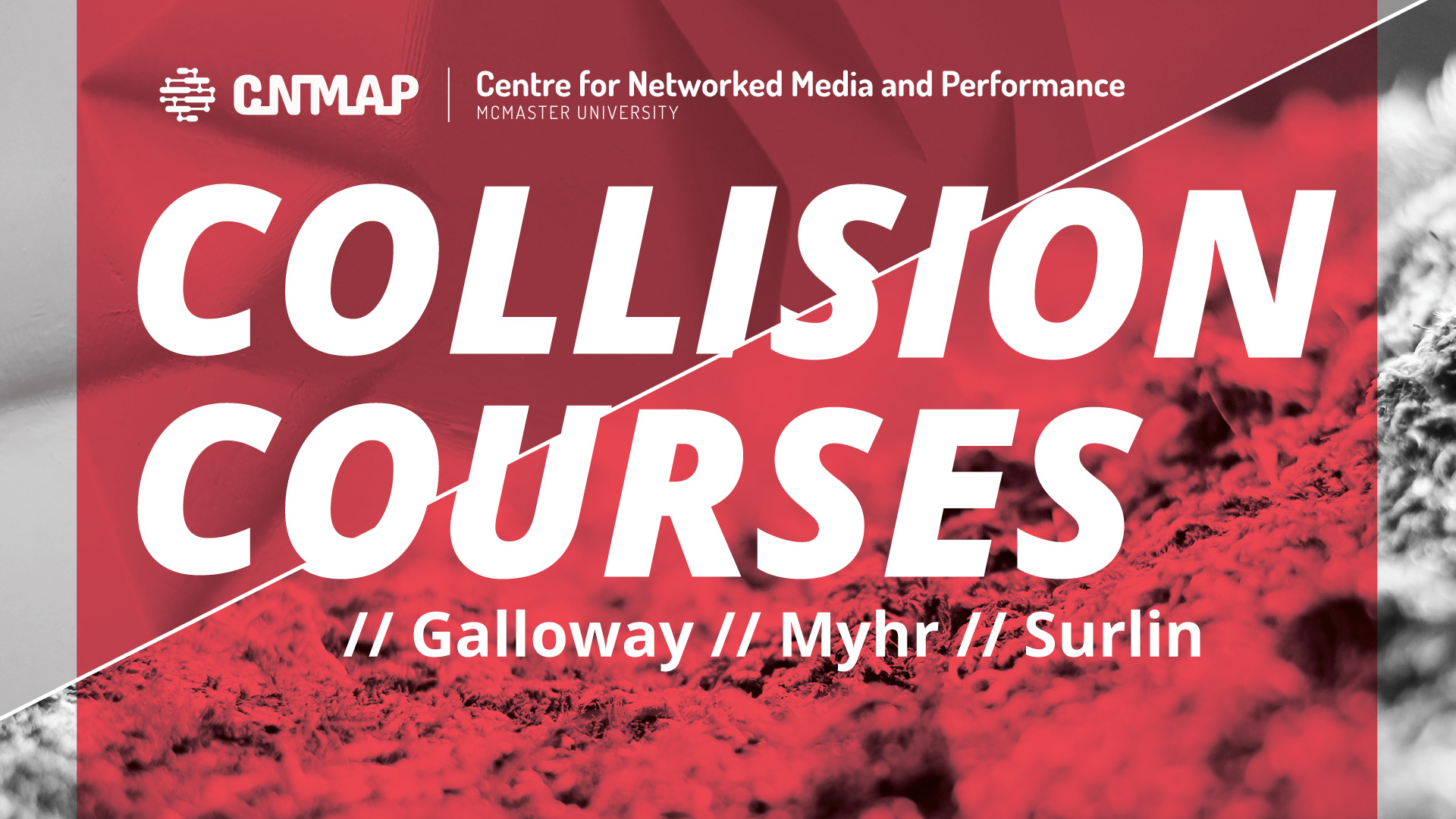
Collision Courses 1 [Galloway/Myhr/Surlin]
18 April 2019, 1:30 - 4:30 PM
Black Box Theatre, L.R. Wilson Hall
The launch of CNMAP’s Collision Courses series, bringing together artist and CNMAP faculty researcher Chris Myhr, invited guest Dr. Kate Galloway, and PhD candidate Stephen Surlin for three talks followed by open discussion and a reception. Surlin will focus on historical models of racial segregation and how they correlate with the distribution of digital network infrastructure, leading to the design of networks to subvert or circumvent current information sharing platform paradigms. Myhr will outline his ongoing body of work “Point-Line-Intersection”, exploring the complex interrelationships between humans, non-humans, and the medium of water. Galloway will listen to the wave of North American Indigenous video games that encourage Indigenous cultural expression, ecological awareness, and combat the misrepresentation and appropriation of Indigenous communities and culture in the mainstream game industry through the combination of activist play, design, code, art, and sound.
Black Box Theatre, L.R. Wilson Hall
The launch of CNMAP’s Collision Courses series, bringing together artist and CNMAP faculty researcher Chris Myhr, invited guest Dr. Kate Galloway, and PhD candidate Stephen Surlin for three talks followed by open discussion and a reception. Surlin will focus on historical models of racial segregation and how they correlate with the distribution of digital network infrastructure, leading to the design of networks to subvert or circumvent current information sharing platform paradigms. Myhr will outline his ongoing body of work “Point-Line-Intersection”, exploring the complex interrelationships between humans, non-humans, and the medium of water. Galloway will listen to the wave of North American Indigenous video games that encourage Indigenous cultural expression, ecological awareness, and combat the misrepresentation and appropriation of Indigenous communities and culture in the mainstream game industry through the combination of activist play, design, code, art, and sound.

Stephen Surlin_ A Critical Race and Technology Approach to Digital Networks, Information Economy and the Archive
This talk focuses on historical models of racial segregation, how they correlate with the distribution of digital network infrastructure, and the effects this has on civic engagement. This may lead to the design of digital and non-digital networks to subvert or circumvent current digital network and information sharing platform paradigms.
Stephen Surlin works in multiple mediums including, 3D modeling, 3D printing, sound design, and musical performance. Surlin’s work and research often uses speculative design and design thinking methodologies to imagine near futures and produce diegetic prototypes that can influence our strategies in the present. He received his BFA at University of Windsor and an MDes from OCAD University and is currently enrolled in McMaster University’s PhD program in Communication, New Media and Cultural Studies, with a focus on creating archives using new media and the digital networking infrastructure needed to sustain them.

Chris Myhr_ Point-Line-Intersection
Myhr will outline an ongoing body of work, entitled Point-Line-Intersection, which explores the complex interrelationships between humans, non-humans, and the medium of water - focusing on the ways in which the ocean and its tributaries influence culture, history, and our collective imagination. The talk will include a screening of Myhr’s most recent audio-visual artwork titled Fathoms: The Weight of Smoke. Fathoms ruminates on the idea of water as a medium through which organization and entropy operate simultaneously. The ocean acts as both a generative/constructive influence, as well as an agent of immense and unpredictable destructive power. It is from this medium that all things originate, and will eventually return.
The film features layered imagery of the camera moving through clouds of underwater sediment hovering above the seafloor off the coast of Nova Scotia. Motion-graphic elements trace vector drawings of Gulf Stream currents - approaching, receding, and shifting in and out of focus. Sound design of the work is comprised of ambient recordings from the spaces within various sea-faring artifacts recovered from the Atlantic Ocean (i.e. ceramic vessels, bottles, artillery shells). Fathoms: The Weight of Smoke was produced through support from the Canada Council for the Arts.
Chris Myhr completed undergraduate studies at Simon Fraser University and the University of Lethbridge, before finishing graduate work at NSCAD University in Halifax. He currently teaches in the Department of Communication Studies & Multimedia at McMaster University.

Kate Galloway_ Indigenous Circuits and Sound Bytes: Negotiating Traditional Ecological Knowledge in Game Sound
Galloway explores the wave of North American Indigenous video games that encourage Indigenous cultural expression, ecological awareness, and combat the misrepresentation and appropriation of Indigenous communities and culture in the mainstream game industry through the combination of activist play, design, code, art, and sound. Drawing on examples from Indigenous-developed or co-developed games—including, for example Never Alone (2014), which follows the quest of a young Inupiaq girl and an arctic fox through the remote landscapes of the Arctic in search of the source of an eternal blizzard threatening their community, Invaders (2015), an Indigenous reformation and indigenization of the classic Space Invaders (1978), and Honour Water (2016), an Anishinaabe singing game app that brings awareness to threats to the waters and Traditional Ecological Knowledge (TEK)—I listen deeply to the multisensory ways game sound and music are used to resound Indigenous futures, ecological relationships and crises, and ways of knowing the land.
This presentation explores the wave of North American Indigenous video games that encourage Indigenous cultural expression, ecological awareness, and combat the misrepresentation and appropriation of Indigenous communities and culture in the mainstream game industry through the combination of activist play, design, code, art, and sound. Expressions of Indigenous modernity indigenizes video game sound, sample-based compositional practices, remixing tradition to bridge Indigenous history with contemporary lived realities to explore the continuity of Indigenous cultures and creativity in the digital age. In Indians in Unexpected Places, Philip Deloria writes that the American custom of imagining Indians in terms of “primitivism, technological incompetence, physical distance, and cultural difference” has remained “familiar currency in contemporary dealings with Native people” (2004, 4). The approaches taken in Indigenous video game sound design to sampling Indigenous music and sonic environments is a form of musical repatriation and challenges Western concepts of copyright and cultural ownership. Drawing on examples from Indigenous-developed or co-developed games—including, for example Never Alone (2014), which follows the quest of a young Inupiaq girl and an arctic fox through the remote landscapes of the Arctic in search of the source of an eternal blizzard threatening their community, Invaders (2015), an Indigenous reformation and indigenization of the classic Space Invaders (1978), and Honour Water (2016), an Anishinaabe singing game app that brings awareness to threats to the waters and Traditional Ecological Knowledge (TEK)—I listen deeply to the multisensory ways game sound and music are used to resound Indigenous futures, ecological relationships and crises, and ways of knowing the land. These are game environments where Indigenous communities can express themselves and their Indigenous traditions and Indigenous futures on their own terms.
Dr. Kate Galloway specializes in North American music that responds to and problematizes environmental issues and relationships, sonic cartography, radio, sound studies, science and technology studies, new media studies, and the digital humanities. Her monograph Remix, Reuse, Recycle: Music, Media Technologies, and Remediating the Environment under contract with Oxford University Press examines how and why contemporary artists remix and recycle sounds, musics, and texts encoded with environmental knowledge.


